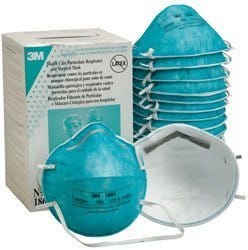There are no emergencies in a pandemic
Or, how to reuse the same N95 mask until it has sweat stains
“There are no emergencies in a pandemic” is the first thing I hear before we start rounds each morning. It’s a ritual from the ICU nursing managers here. Every morning, we are reminded that during the Ebola crisis front line health care workers in Liberia rushed into patient rooms without adequate protection in an attempt to save lives before they ended up becoming patients themselves.
“There are no emergencies in a pandemic” means that we must protect ourselves before we can take care of our patients. Health care workers are a limited resource, and if we get sick, we become a dual burden on the system that we have been trying to help. You can’t take care of patients when you’re sick, and if you need to be taken care of, you’re taking resources away from others who need it.
You’re probably heard in the news that personal protective equipment, or PPE, is a vital part of medical care in the time of COVID that protects us while we are examining our patients and performing invasive procedures.
Here’s a picture of me wearing the PPE that I have available. I was told by a couple of people who saw this picture that my hands are in a weird position and I’m standing awkwardly. Both pieces of feedback struck me as valid and reasonable.

There are 4 vital parts of adequate PPE: respirator mask, gown, eye protection, and gloves.
The most common respirator mask is the N95, which protects against 95% of fine particles in the air, slightly less than the N99 (99%) and the N100 (99.97%). The experience of wearing an N95 is quite unpleasant.

It’s a thick piece of abrasive material that when fitted correctly is pushed tightly up against the skin around your mouth, compressing it to the point that you can feel a skin indentation forming from the second you put it on.
A properly fitted N95 has the magical property of making your breath smell instantly disgusting even if you brushed your teeth just five minutes before. Both fortunately and unfortunately, while wearing an N95, you’re the only one that can smell it. The stifling experience of wearing one makes your entire head feel instantly overheated and almost causes a sensation of air hunger because your breath is so stale.
Each N95 is designed as a single use item. In a time before COVID, my only real experience with N95 masks was for patients with tuberculosis, when I would put a mask on to see the patient and then toss it in the trash when I was done. If I had multiple patient’s with TB, I would use multiple masks each day, so as not to transfer any particles from one room to another. These are designed as a single use item.
With the shortages in equipment that we’ve had in the time of COVID, I’ve been reusing one N95 mask for 2-3 weeks at a time. This is an item that I used to wear for about 15-20 minutes at a time and then throw out to get a fresh one for each patient; now I can wear a single mask for 12 to 13 hours a day for 2 to 3 weeks at a time. We’ve been given paper bags to put our names on so that we can keep our N95 “safe” in the ICU.
My own mask has developed sweat stains and constantly feels damp and musty, like a piece of clothing you took out of the dryer about 15 minutes before the cycle is over, except in this case it was dirty when you put it in the dryer. I started wearing a surgical mask on top of the N95 because we had more of those and I could change that out daily, lessening the spread of particulate matter from day to day.
Beyond the mask, there are gowns, gloves, goggles, and head coverings. We have plastic gowns that are kind of like the material in a plastic bag from the grocery store. I wear one on the front and one on the back. The nitrile gloves are worn 2 pairs at a time, one pair put on before the gowns and one put on after. I have plastic goggles that seem to fog up even though my breath is entirely contained by the N95. And then there’s a bouffant cap that makes me feel like a lunch lady.
The whole get-up is fine for a few minutes at a time when standing in place, and it seems to possess the bare minimum in self protective sufficiency. When I’m wearing it during procedures, I end up sweating so much that my scrubs look like I left them in the rain.
It’s essentially like I’m wearing two layers of plastic bags with a barely breathable face covering and foggy goggles when I’m sticking needles into my patients’ jugular veins. We have enough gowns, gloves, and head coverings that I’ve been able to switch out in each patient room. But the N95 shortage is very real and very palpable.
So before each patient encounter, the ritual is the same. Put on first pair of gloves. Gown in the front. Gown in the back. Goggles. Bouffant. Second pair of gloves. Go into the room and see the patient. There are no emergencies in a pandemic.


You are truly a hero! Awesome writing and sharing. Thank you for all that you do.